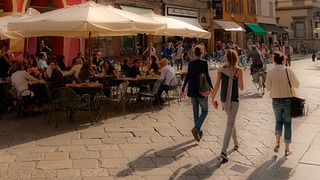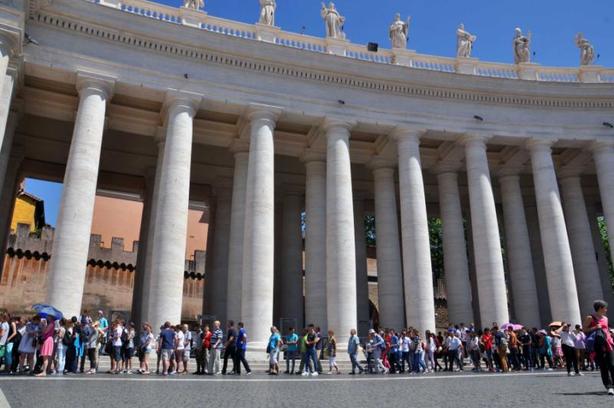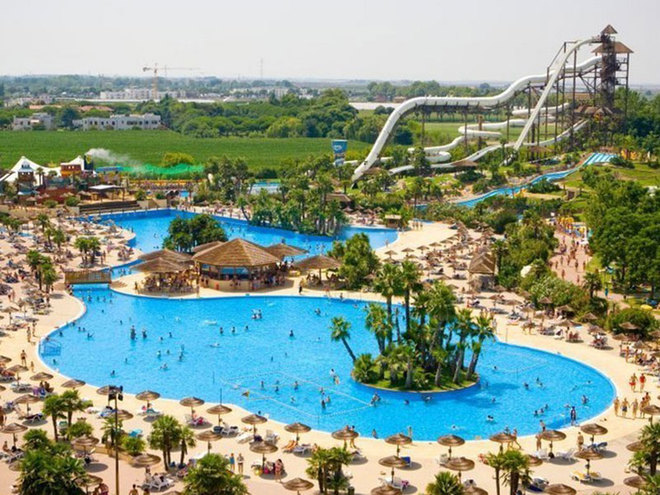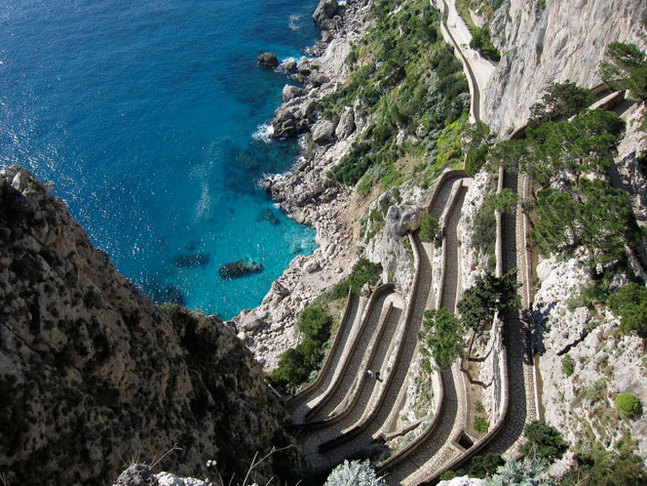It's Hot! Italy is hot--nearly tropical-hot. Pretty much all over the country, too. It's a real task to stay cool in Italy--a country where ice cubes in a drink are thought to give a mal di stomaco, causing tourists to ask for ice in their warm glasses of soda; air conditioning is rarely turned on, or when it is on, is set to 75 degrees (when it exists at all, that is); where a 68 degree evening is considered cold; where Italians don their puffy jackets and scarves when most Americans are in T-shirts and shorts; and where people eat such large, heavy lunches during summer that they need to close up shop and go home to take a nap for a few hours with their shutters drawn against the midday sun. Before we took our trip to Italy, I researched the weather extensively... or so I thought. I had all sorts of long range forecasts, histories of statistics of previous years' weather and temps, and even got first hand personal advice from Italians and travelers on the many online travel forums I frequented at the time. Nothing prepared me for the heat and humidity we encountered... and this was during three weeks in October! We saw many days in the 90s, usually with high humidity. This got me thinking of my niece and her son... they are taking a tour of Italy and Greece in July. July! OMG! I don't know if I could do all the things we did in Italy in the heat of summer. Even in October, Pompeii was roasting us (thank the Lord for those fresh water fountains that were there), Amalfi made us sweat more than we thought our bodies could, and the Vatican Tour exhausted us beyond belief due to the extra BTUs produced by the throngs of tour groups pressing bodies like cattle trying to get through those narrow, un-airconditioned, stuffy, humid palace halls. Curiously, in the southern province of Puglia, it seemed cooler than up in Tuscan or Rome--the sea breezes kept us more comfortable. Walking the streets of Rome we found especially grueling (like Manhattan, big cities hold heat), but not as awful as I imagine it must be to deal with the summer heat in Italia. In fact, summer temperatures in Rome can reach as high as 104F! So I would strongly recommend when planning a trip to Italy that you plan it in the shoulder season months in early spring--March, April, May--or the fall during late September, all of October up to the first 2 weeks of November. After that, the rainy season comes to most of Italy. But in case you have to be in Italy during summer, I've put together some tips on beating the heat when in Italy during the hottest months... especially helpful for those of you traveling with very young or older people susceptible to overheating and exhaustion.  Sweltering crowds at the Uffizi in Florence Sweltering crowds at the Uffizi in Florence Avoid Long Lines When Possible: There are many things to see in Rome, Florence and the rest of Italy that don't require standing on long lines. Think out of the box. Even if you throw away your "must see" list of the top tourist attractions, you will still enjoy yourself and get a good taste of Italian life. Don't plan anything that requires long lines. I know this rules out things like the Vatican, the Uffizi in Florence, but believe me, I witnessed the long lines in October and can't imagine how much longer they get in the high tourist season. The lines at the Vatican can be three hours long unless you have booked a private tour, and even though St Peters is free to all, everyone has to go through the long lines for a security check... up to 3 hours in high season. You can try going either early (before 9am) or later in the afternoon when the tourist groups are gone. They are open until 7pm, so if you get there for 5pm you'll have shorter lines and still have some time to walk through. On Sunday's if you want to attend mass, again, the earlier the better.  Drink Water, Lots of Water: You should bring a refillable bottle and trust the fountains for refilling your bottle unless it says "non potabile". Buying water bottles or sodas at tourist snack wagons will begin to add up, so refilling your own will help hold down costs. (I recommend this Thermos brand bottle. With some ice it keeps drinks icy cold for hours). Select a travel bag with a large enough drink bottle pocket. You won't always find a vendor or bar when you need one, but you will find water fountains... many times, ancient Roman ones with brass faucets sticking out of them. Consider bringing a bandanna that you can wet and tie around your neck, or fold and soak it and put it under your kids' caps. Lucas loved this technique for keeping cool.
Think Like an Italian and take a Riposa: Italians don't go out in the hottest part of the day. They take long 3 hour lunches called a riposa--a siesta, if you will. Most go home for lunch. Think like an Italian and don't plan a lunch in small towns after 12 noon or you won't be able to find a restaurant open for lunch (in larger cities like Rome or Florence this isn't a problem). But in most other towns, look for bars--in Italy, a bar is a place to get snacks, pastries, sandwiches and espresso. Plan picnic lunches and a rest period in the middle of the hot day. Sit under a tree, have your lunches, dangle your feet in a stream or fountain, or plan to visit a cool church. It's a bit cooler inside old castles and churches with their thick walls and marble floors. When you can, get out early to get your tourist things done, relax back in your hotel of rental apartment like an Italian, then go to museums and such after 4pm when most of the tour buses and cruise ship crowds are long gone.  Don't Walk During Midday: Do your long walks in the morning and late in the day when the sun is low. Plan indoor things for midday... or even plan on spending restful time in your air conditioned hotel room until later in the day. You won't miss anything... Rome, Florence, Pisa, Amalfi, Venice... they're all still there later in the day and in the evening--and less crowded.
 Water Pistols: Yes, I'm serious. If you're traveling with a few little ones, pack a couple of small, good quality water pistols and let them shoot each other to their little hearts' content. They will have less tantrums and meltdowns if they're getting cool by getting wet. (On occasion, I'd sprinkle some water down my boy's neck to cool him down). If you're tight on space, pack a couple of kitchen sized plastic hypos. They can suck water up from a fountain and shoot pretty far with these things.
 Italian Water Parks: Yes, they have water parks in Italy too. Beautiful, big ones. Personally, I think this would be something a family might want to do only if they are staying for an extended period of time in Italy... after all, it's not like you'd experience anything about the Italian culture in a modern water park. But if you are staying in a hub location for three weeks or more, you might want to take a break and treat the family to some wet, cool fun at a local water park. For example, just to the east of Venice in the resort beach town of Jesolo is Aqualandia, a large seaside water park 2 huge lagoon sized pools with a tropical island and other water slide attractions. One of the oldest and most famous water parks is Aquafan in Riccione one quarter of the way down the Adriatic coast side of the Boot. Again, I'd only recommend this for long term stays in Italy when your family needs a break from all the typical tourist activities and just wants to let loose and cool down. Personally, water theme parks are not my thing... I'd rather hit the real beaches in Italy...
 Shady Side of the Street: Only "Mad dogs and Englishmen go out in the midday sun"--that's what Noel Coward said. I'm sorry to say that my wife hasn't a clue as to what side of the street to walk on when it's hot and sunny. Lucas and Lisa might get miffed when I turn a corner and abruptly say "let's walk on the other side". They don't notice the broiling sun on one side and the shade trees on the other. Maybe I notice because I'm a lot older than both of them put together, I'm carrying more weight than ever before, and have that little balding spot that burns way too easily when I forget my cap. Perhaps the other reason is because light is my science--being a professional photographer. I pay attention to light and shadows. Walk on the shady side and stay 15 - 20 degrees cooler. Some walks in Rome, for instance, are on very long, sunny boulevards. If you're lucky enough to be walking in a town like Bologna, you can walk for 0ver 40 miles of arcades and stay out of the sun.  Pack a Portable Fan: A battery operated fan can be useful in many situations when traveling in Italy during the summer. You can use it on a train, especially regional lines whose air conditioning or ventilators might not be operating properly. You can put it on your table during meals pointing right at your face and neck. You can use it in hotel rooms where the A/C isn't up to snuff. If you've just endured a long walk up to the Centro Storico of a hilltown, you can find a shady place to sit, pop out your portable fan and cool down for a few minutes until your body temperature comes down a bit. Hint: Wipe your face and neck with a Wet One and enjoy the cooling evaporative effect as you point the fan at yourself. Take a Head Shower: When you are at your body's limits on how much heat you can endure, look for a public potable water fountain and hold your head under it... wetting your hair and all. If you're sweaty and worn out looking anyway, who cares about how your wet hair will look... just think about how refreshing it will feel. This type of head shower will work especially well in the public fountains in places like Pompeii or towns like Lucca.  Taxis and Car Services: By all means, learn how to get a taxi in the large cities. Most cities like Rome have taxi stands where taxis wait on the cue (the one in front is the next one to take a fare). You don't hail a taxi in Rome unless they have a legal place to pull over. They are very affordable and will save both your feet and your sweat glands. Take a taxi up to a city center and then meander casually back to your starting point. In case your driver doesn't have his air conditioner set cool enough, ask "il condizionatore d'aria ... più fresco per favore?" (the air conditioner... cooler please?) For more about taxis in Rome, read Rome Taxiphobia: Much Ado About Nothing. Besides taxi stands, ask your hotel for the numbers of the best radio taxi services. They work like Uber--call them, tell them your location (more often, you need to do this in Italian!) and they will show up within minutes. The taxi meter starts running when the taxi driver starts out toward your location. You can also try Uber in Rome and Florence. In places like the Amalfi Coast, use a car service instead of using the bus. The buses are not always on time and you might find yourself waiting for a long time standing in the bright sun on the side of a very narrow, busy, curvy road.  One Word... GELATO: That's right. One of the easiest ways to cool down is find a gelateria (which won't be too hard as they are everywhere and pretty much are always open) and ask for a scoop (or two) of your favorite flavor. I'm sure you'll even find flavors that you didn't know were your favorite! And don't worry about gelato spoiling your kid's appetites. Gelato, although having less air makes it taste richer than ice cream, is far lower in fat and sugar than ice cream. Have gelato at 5 or 6pm before the 7:30 Italian dinnertime starts. And there's a lot more than just gelato... granita, semifreddo, sorbetto, grattachetta, shakerato (ice espresso). Check out my blog post Frozen... to learn more.  Close the Shutters: If you are staying in a hotel room or apartment or villa, they will most likely all have shutters. In the U.S. shutters have devolved into being only a decoration, screwed in the open position. In Italy they actually work and are a necessity. Close shutters in your rooms before going out for the day and your home away from home will be cooler when you get back. This is especially important for the midday period. There are a lot of family lunches and naps going on behind all those drawn shutters in Italian towns.  Take Rest Stops on Steps and Inclined Walkways: There are lots of steps and sloped walkways in Italy. Hilltowns are everywhere. If you are driving, most parking lots are outside the lower party of hilltowns--you aren't permitted to drive in the historic centers (centro storico). There will be a lot of walking uphill and lots of steps. For example, in Positano (on the Amalfi Coast) there are over 2000 steps that many climb to get high above the town to see the amazing views of the sea. On the Isle of Capri there are steep switchback paths that you need to walk to get down to the beach. Many towns in Italy have similar paths that used to be used for donkeys but are still used for getting from one place to another. Air Conditioning: Air conditioning in Italy isn't the same as here at home. First of all, Italians don't like drafts and might keep the air conditioning turned off completely or the temperature set at 78F (25C) instead 68F (20C). I even ran into one hotel that had a master control... you had to call the desk to have them turn it on, and they couldn't change the thermostat. It was one set temperature that definitely wasn't refreshing at all. If their system is broken down, chances are it won't be fixed during your stay. The best air conditioning I've found is in the bigger cities and from "split duct" systems... the kind where you see a big bulky air handler unit mounted high on one wall. The radiator-looking systems barely cool at all. You might inquire about they type of air conditioning before booking an apartment, especially if you're planning a longer stay. Even in shops, restaurants and museums, I found most air conditioning systems to be way under par from what we're used to in the States. When you do find a very cool setup, savor it... you may not find it again. The Italian Coast and Beaches: There are 4722 miles of coastline in Italy, some of it are rugged and rocky, but most of it are beaches... everything from fine snow white sand to pink, to black to pebbles to rocky. You can take your pick from the chic Lido beaches of Venice to the Italian Riveria to the miles of pristine sand and rocky cove beaches of Puglia. Some beaches are packed like sardines with Italian families on their August holiday, many are overbuilt and crowded, while much of the Italian coastline (including Sicily and Sardinia) have mile after mile of some of the most unspoiled beaches anywhere in the world. And the great thing is (as in Puglia) many are just there for the taking. Free. Mother nature's gift to the tired and overheated traveler. If you want a natural beach experience, check out the Maremma in Tuscany (A Tuscan Beach Vacation: The Maremma). Don't forget to pack swim suits for summer travel!  Head North to the Italian Alps: For nature lovers, trekkers, bikers and even skiers (at higher elevations), there is a great opportunity to stay cool in the Italian summer--the Italian Alps. With over 300 sunny days a year and much cooler temperatures than the rest of Italy, the Italian Alps, with its mix of Italian and South Tyrolean cuisine, is a wonderful way to beat the heat. The food here very different--there might be risotto, lardo (an paper thin-sliced herbed, cured lard) fonduta (Italian style fondue), Canederli (a sort of Matzo ball dumpling in broth), fontina and goat cheeses, sausages, wines and of course, beer. But the real star of the show up north is the world famous, UNESCO World Heritage Dolomites--amazing, jagged pinnacles jutting up from the top of Italy's boot. While there, you can ride cable cars up from the valley or enjoy adventure sports like paragliding, zip-lining, mountain climbing, river rafting and glacier trekking.  Gassata or frizzante... bubbly and refreshing. Gassata or frizzante... bubbly and refreshing. Forget the Soda and Drink Gassata: First of all, American style sweet sodas might taste the same in Italy, but can be very costly, especially when purchased at street vendors in tourist areas and in restaurants. Another thing on sodas... you will not find diet soda. I didn't see one brand of diet soday in all of Italy when we were there. Instead, order large bottles of "gassata" or "frizzante" (both mean sparkling water). Order one large bottle with meals. If you want plain water, order a bottle of "aqua naturale". Add the word "fresci" or "freddo" to ensure that the bottle they bring has "fresh" or "cold" come from a fridge. Local alimentari (grocery stores) will have large bottles of gassata in their cooler or you can buy a large bottle to bring back to your hotel fridge. The only other soda I'd recommend in Italy is Fanta Aranciata (orange). It is different in Italy--and better--made with natural orange juice... a light, refreshing, sparkling orangeade. Personally, I find the Sanpellegrino orange and lemon sodas way too acidic. So, if you insist on going to Italy during the hottest time of the year, please stay cool and slow down. You might even have to knock some things off your list, but you'll have a much better time and stay healthier.
Stay cool, or as Italians put it, mantenere il sangue freddo! (Keep your blood cool) --Jerry Finzi If you liked this article, please share it with your friends! Ciao! You can also follow Grand Voyage Italy on: Google+ StumbleUpon Tumblr
0 Comments
Your comment will be posted after it is approved.
Leave a Reply. |
Categories
All
Archive
June 2024
|
















 RSS Feed
RSS Feed
